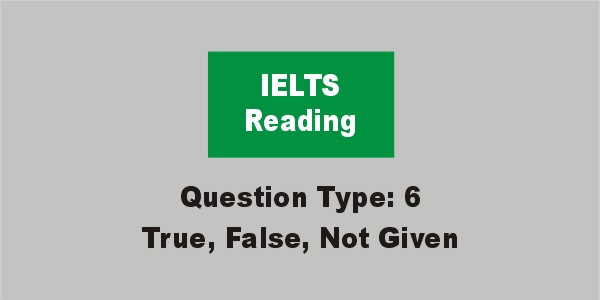True means that information in the text 100% matches with the question. False means that information is opposite to the questions. Not Given means that information doesn’t exist in the passage. If they ask you to write Yes or No and you write True or False, the answer will be technically wrong even if it is right. Don’t try to find Not Given. If it is not given, you can’t find it. If a question takes more time, very likely the answer is Not Given.
Look at the following examples:
True Scenario
For a statement to be true, the passage must clearly support the information stated in that statement.
Statement:
The Red-Eyed Jungle Moth mates between the months of March and June.
Passage:
Mating occurs in the second quarter of the year for the Red-Eyed Jungle Moth.
False Scenario
For a statement to be false, the passage must clearly state that the information in the passage is not true.
Statement:
The Red-Eyed Jungle Moth mates between the months of March and June.
Passage:
For the Red-Eyed Jungle Moth, mating only happens in the second half of the year.
Not Given Scenario
For a statement to be not given, there must be no information in the passage relating to the information in the statement.
Statement:
The Red-Eyed Jungle Moth mates between the months of March and June.
Passage:
Moths in the lower tributary areas normally breed in the spring months.
This extract from the passage does not clearly state anything relating to the Red-Eyed Jungle Moth or the specific period mentioned in the statement.
Now look at the following examples then solve the questions given at the end.
Look at this statement, taken from the first sentence in the reading below:
Chiles originate in South America and have been eaten for at least 9,500 years.
Here are some example IELTS “True”, “False” and “Not Given” statements with answers:
A: Chiles come from South America – True
Number one is clearly true. Notice the use of the synonym ‘come from’ used instead of ‘originates’. It is common to use different words.
B: People began eating Chiles in the last few centuries – False
Two is clearly false as it was 9,500 years ago, not a few 100 years ago.
C: South Americans were the first people to start eating Chiles – Not Given
Three is not in the text. Be careful about making assumptions that it is true. It is quite probable the South Americans began eating Chiles first as they originated there; however, you can’t be sure of that and the text does not tell you that.
Now, read the following text and answer the questions using either True, False, or Not Given.
|
Chilies
Chiles originate in South America and have
been eaten for at least 9,500 years. Organised cultivation began around 5,400BC. Christopher Columbus was the first European to encounter chilies, when he landed on the island of Hispaniola in 1492. He thought it was a type of pepper and called it the “red pepper”, a name still used today. After their introduction to Europe they were an immediate sensation and were quickly incorporated into the diet. From there they spread to Africa, India and East Asia. The reason for the chili’s “hotness” lies in a
chemical called Capsaisin. Capsaisin causes temporary irritation to the trigeminal cells, which are the pain receptors in the mouth, nose and throat. After the pain messages are transmitted to the brain, endorphins, natural pain killers, are released and these not only kill the pain but give the chili eater a short lived natural high. Other side effects include: an increased heart rate, a running nose and increased salivation and sweating, which can have a cooling effect in hot climates. The reason for the presence of Capsaisin is
thought to be to deter animals from eating the fruit. Only mammals feel the burning effects; birds feel nothing. As birds are a better method of distributing the seeds, which pass intact through their guts, Capsaisin would seem to be a result of natural selection. The smaller chilies tend to be the hottest.
This may reflect the fact that they tend to grow closer to the ground and are therefore more vulnerable to animals. The heat of a chili is measured on the Scoville scale. The hottest types such as the Habenero and the Scotch Bonnet rate between 100,000 and 300,000, the world famous Tabasco sauce rates at 15,000 to 30,000, about the same as the Thai prik khee nu, while the popular Jalapeno is between 5,000 and 15,000. Powdered chili is 500 to 1,000 and the mild capsicins and paprikas can range between 100 and 0. |
1. Chilies became popular as soon as they were brought into Europe.
Hint: Notice these synonyms and give the answer.
Became popular = sensation
As soon as = immediately
Brought into = introduced
2. Capsaisin damages the mouth.
Hint: Notice the opposing words as:
Damage = Temporary irritation
3. Chilies can be part of a birds diet.
Hint: Notice such words in the text as:
Feel nothing; distribute.
4. All large chilies grow high off the ground.
Hint: Notice small chilies growth and ground.
5. People breed chilies for their heat.
Hint: Find the heat of Chilies and then try to find the reason.


1. True
2. False
3. True
4. Not Given
5. False
CHECK YOUR ANSWERS:
1. True
2. False
3. True
4. Not Given
5. Not Given.